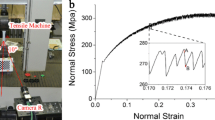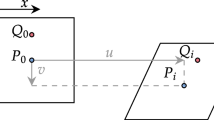Abstract
This paper deals with the grid method in experimental mechanics. It is one of the full-field methods available for estimating in-plane displacement and strain components of a specimen submitted to a load producing slight local deformation. This method consists in, first, depositing a regular grid on the surface of a specimen, and, second, comparing images of the grid before and after deformation. A possibility is to perform windowed Fourier analysis to measure these deformations as changes of the local grid aspect. The aim of the present study is to investigate the choice of the analysis window and its influence on the metrological performances of the grid method. Two aspects are taken into account, namely the reduction of the harmonics of the grid line profile, which are not pure sine because of manufacturing constraints, and the transfer of the digital noise from the imaged grid to the mechanical measurements. A theoretical study and a numerical assessment are presented. In addition, the interested reader can find in this paper a calculation of the Wigner–Ville transform of a triangular function which, to the best of the present authors’ knowledge, is not available in the existing literature.














Similar content being viewed by others
References
Abrahamsen, P.: A review of Gaussian random fields and correlation functions. Technical report, Norwegian Computing Center, Oslo (1997)
Avril, S., Ferrier, E., Vautrin, A., Hamelin, P., Surrel, Y.: A full-field optical method for the experimental analysis of reinforced concrete beams repaired with composites. Compos. A 35(7–8), 873–884 (2004)
Badulescu, C., Grédiac, M., Mathias, J.D.: Investigation of the grid method for accurate in-plane strain measurement. Meas. Sci. Technol. 20(9), 095,102 (2009)
Badulescu, C., Grédiac, M., Mathias, J.D., Roux, D.: A procedure for accurate one-dimensional strain measurement using the grid method. Exp. Mech. 49(6), 841–854 (2009)
Balandraud, X., Barrera, N., Biscari, P., Grédiac, M., Zanzotto, G.: Strain intermittency in shape memory alloys. Physi. Rev. B 91(17), 174, 111 (2015)
Chrysochoos, A., Surrel, Y.: Basics of metrology and introduction to techniques. In: Grédiac, M., Hild, F. (eds.) Full-Field Measurements and Identification in Solid Mechanics, pp. 1–29. Wiley, Hoboken (2012)
Cohen, L.: Time-Frequency Analysis. Prentice-Hall, Upper Saddle River (1995)
Dai, X., Xie, H., Wang, Q.: Geometric phase analysis based on the windowed Fourier transform for the deformation field measurement. Opt. Laser Technol. 58, 119–127 (2014)
Delpueyo, D., Grédiac, M., Balandraud, X., Badulescu, C.: Investigation of martensitic microstructures in a monocrystalline Cu-Al-Be shape memory alloy with the grid method and infrared thermography. Mech. Mater. 45(1), 34–51 (2012)
Flandrin, P.: Separability, positivity, and minimum uncertainty in time-frequency energy distributions. J. Math. Phys. 39(8), 4016–4040 (1998)
Grédiac, M., Sur, F.: Effect of sensor noise on the resolution and spatial resolution of displacement and strain maps estimated with the grid method. Strain 50(1), 1–27 (2014)
Grédiac, M., Sur, F., Blaysat, B.: The grid method for in-plane displacement and strain measurement: a review and analysis. Strain (2016). To be published
Grédiac, M., Toussaint, E.: Studying the mechanical behaviour of asphalt mixtures with the grid method. Strain 49(1), 1–15 (2013)
Harris, F.: On the use of windows for harmonic analysis with the discrete Fourier transform. Proc. IEEE 66, 51–83 (1978)
Healey, G., Kondepudy, R.: Radiometric CCD camera calibration and noise estimation. IEEE Trans. Pattern Anal. Mach. Intell. 16(3), 267–276 (1994)
Hlawatsch, F., Boudreaux-Bartels, G.: Linear and quadratic time-frequency signal representations. IEEE Signal Process. Mag. 9(2), 21–67 (1992)
Huang, L., Kemao, Q., Pan, B., Asundi, A.: Comparison of Fourier transform, windowed Fourier transform, and wavelet transform methods for phase extraction from a single fringe pattern in fringe projection profilometry. Opt. Lasers Eng. 48, 141–148 (2010)
Huntley, J.: Automated fringe pattern analysis in experimental mechanics: a review. J. Strain Anal. Eng. Des. 33(2), 105–125 (1998)
JCGM member organizations: International vocabulary of metrology. Basic and General Concepts and Associated Terms (VIM) (2008)
Kemao, Q.: Windowed Fourier transform for fringe pattern analysis. Appl. Opt. 43(13), 2695–2702 (2004)
Kemao, Q.: Two-dimensional windowed Fourier transform for fringe pattern analysis: Principles, applications and implementations. Opt. Lasers Eng. 45(2), 304–317 (2007)
Mallat, S.: A Wavelet Tour of Signal Processing, 2nd edn. Academic Press, Cambridge (1999)
Molimard, J., Surrel, Y.: Grid method, moiré and deflectometry. In: Grédiac, M., Hild, F. (eds.) Full-field Measurements and Identification in Solid Mechanics, pp. 61–89. Wiley, Hoboken (2012)
Moulart, R., Rotinat, R., Pierron, F., Lerondel, G.: On the realization of microscopic grids for local strain measurement by direct interferometric photolithography. Opt. Lasers Eng. 45(12), 1131–1147 (2007)
Murthagh, F., Starck, J., Bijaoui, A.: Image restoration with noise suppression using a multiresolution support. Astron. Astrophys. 112, 179–189 (1995)
Peevers, A.W.: A real time 3D signal analysis/synthesis tool based on the short time Fourier transform. Technical report, Department of Electrical Engineering, University of California, Berkeley (2004)
Pierron, F., Zhu, H., Siviour, C.: Beyond Hopkinson’s bar. Philos. Trans. R. Soc. A 372(2023), 20130,195 (2014)
Pitti, R.M., Badulescu, C., Grédiac, M.: Characterization of a cracked specimen with full-field measurements: direct determination of the crack tip and energy release rate calculation. Int. J. Fract. 187(1), 109–121 (2014)
Reu, P.L., Quintana, E., Lon, K.: Using sampling moiré to extract displacement information from X-ray images of molten salt batteries. In: Conference Proceedings of the Society for Experimental Mechanics Series, Vol. 3, pp. 331–336 (2014)
Ri, S., Muramatsu, T., Saka, M., Nanbara, K., Kobayashi, D.: Noncontact deflection distribution measurement for large-scale structures by advanced image processing technique. Mater. Trans. 53(2), 323–329 (2012)
Sur, F., Blaysat, B., Grédiac, M.: Determining displacement and strain maps immune from aliasing effect with the grid method (2016). Submitted for publication
Sur, F., Grédiac, M.: Towards deconvolution to enhance the grid method for in-plane strain measurement. AIMS Inverse Probl. Imaging 8(1), 259–291 (2014)
Sur, F., Grédiac, M.: On noise reduction in strain maps obtained with the grid method by averaging images affected by vibrations. Opt. Lasers Eng. 66, 210–222 (2015)
Surrel, Y.: Design of algorithms for phase measurements by the use of phase stepping. Appl. Opt. 35(1), 51–60 (1996)
Surrel, Y.: Additive noise effect in digital phase detection. Appl. Opt. 36(1), 271–276 (1997)
Surrel, Y.: Fringe analysis. Photomechanics. Topics in Applied Physics, vol. 77, pp. 55–102. Springer, Berlin (2000)
Wittevrongel, L., Lava, P., Lomov, S., Debruyne, D.: A self adaptive global digital image correlation algorithm. Exp. Mech. 55(2), 361–378 (2015)
Acknowledgments
This work is partially funded by GdR CNRS ISIS (Timex project).
Author information
Authors and Affiliations
Corresponding author
Appendices
Proof of Proposition 1
Proof
Let E be the expectation of any random variable. Since n is a white noise of variance v, we have \(E(n(x_i,y_j)n(x_k,y_l)) = 0\) if \(x_i\ne x_k\) or \(y_j\ne y_l\), and \(=v\) otherwise.
By expanding the real and imaginary parts of \(\widehat{n}\) and replacing the discrete Riemann sums by integrals:
Let us define:
We obtain:
where \(\alpha =(\xi -\xi ')/2\).
Since the analysis window is symmetric, we have \(w^{\mathbf {x}}_{\sigma _x}(x-\alpha )=w^{\mathbf {x}}_{\sigma _x}(\alpha -x)\). In addition note that
where \({{\mathcal {W}}}t_\sigma \) is the Wigner–Ville transform of the 1D window \(w^{\mathbf {x}}_{\sigma _x}\). Equation (52) follows.
Concerning the imaginary part of the noise:
Thus, the same route as the preceding one gives (53).
Moreover,
which gives, in a similar fashion, (54). \(\square \)
Wigner–Ville Transform of Some Windows
The Wigner–Ville transform of the rectangular and Gaussian windows can be found in the literature [7, 22]. However, they sometimes contain typos. For the sake of completeness, we give here the calculation of these transforms. We also give the calculation of the Wigner–Ville transform of the triangular windows, which we have not been able to find in the available literature.
A numerical assessment is provided at the following URL: http://www.loria.fr/~sur/software/VerifWV/
By definition, \({{\mathcal {W}}}f(x,\lambda )=\int f(x+\tau /2)f(x-\tau /2)e^{-i\tau \lambda } \;\text {d}\tau \). Since f is symmetric,
Since \({{\mathcal {W}}}f(-x,\lambda )={{\mathcal {W}}}f(x,\lambda )\), we assume, without loss of generality, that \(x\ge 0\).
1.1 Rectangular Window
Here, \(f=r_a\) in Table 1. For any \(u\in [-a,a]\),
Thus, for any \(x\in {\mathbb {R}}\),
The value for \(\lambda =0\) is given by a Taylor expansion, that is,
1.2 Triangular Window
Here, \(f=t_b\) in Table 1:
Moreover, if \(x\ge b\), \({{\mathcal {W}}}f(x,\lambda )=0\).
First case. \(b/2\le x\le b\). We calculate successively
On the one hand,
On the other hand,
Thus,
Second case. \(0\le x \le b/2\). We calculate successively
Now,
Consequently,
Conclusion. For any \(x\in {\mathbb {R}}\), the Wigner–Ville transform of the triangle function writes
The value for \(\lambda =0\) is given by a Taylor expansion:
1.3 Gaussian Window
Note that generalized Gaussian functions give positive Wigner–Ville transform, and only them [10]. The Wigner–Ville transform of a Gaussian function writes as follows:
since the Fourier transform of \(e^{-x^2/\sigma ^2}\) is \(\sqrt{\pi }\sigma e^{-f^2\sigma ^2/4}\).
Noise Derivative with a Birectangular or Triangular–Rectangular Window
Let X(t) be a stationary random process of covariance function C(u). For any \(\varepsilon >0\), the covariance of \(\frac{X(t+\varepsilon )-X(t)}{\varepsilon }\) writes as follows.
with \(u=t-t'\).
When the second derivative of the covariance function C exists, this latest term converges to \(-C''(u)\) as \(\varepsilon \) tends to 0. This makes it possible to define the mean-square derivative \(X'(t)\) of the random process X at t as soon as the second derivative exists; the covariance function of X(t) being \(-C''(t)\).
This obviously generalizes to stationary random fields (see, e.g., [1]). In the case of rectangular windows, the second derivatives do not exist. However, actual computations do not depend on the mean-square derivatives, but instead on a finite difference scheme.
If a central difference scheme of step \(\varDelta _x=1\) pixel is used to estimate the derivatives,
which is the opposite of the second derivative of C (in the sense of the central difference scheme), denoted here by \(-\varDelta ^2C\). The problem is to compute the noise covariance in the case of birectangular and triangular–rectangular windows, thus to compute the \(-\varDelta ^2 r_a*r_a(u) = -\frac{1}{2} \varDelta ^2 {{\mathcal {W}}}r_a(u/2,0)\).
A straightforward calculation gives
Rights and permissions
About this article
Cite this article
Sur, F., Grédiac, M. Influence of the Analysis Window on the Metrological Performance of the Grid Method. J Math Imaging Vis 56, 472–498 (2016). https://doi.org/10.1007/s10851-016-0650-z
Received:
Accepted:
Published:
Issue Date:
DOI: https://doi.org/10.1007/s10851-016-0650-z




